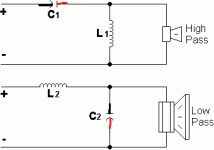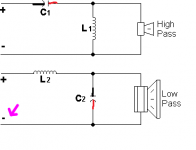hi all  ,
,
i have a doubt.
on audience (auricap) site there are the following suggestions:
In loudspeaker crossover applications, if the Auricap is in series, like feeding a tweeter, the black lead connects to the input binding post and the red lead connects to the tweeter. Where the Auricap is in parallel, as typically used for woofers, the black lead connects to the speaker connection that connects to the input binding post and the red lead connects to the other speaker terminal. Follow these same rules for midrange connections where you will have a combination of both.
but to me is not so clear: could someone post me the diagrams of the two positions described ?
thank you
i have a doubt.
on audience (auricap) site there are the following suggestions:
In loudspeaker crossover applications, if the Auricap is in series, like feeding a tweeter, the black lead connects to the input binding post and the red lead connects to the tweeter. Where the Auricap is in parallel, as typically used for woofers, the black lead connects to the speaker connection that connects to the input binding post and the red lead connects to the other speaker terminal. Follow these same rules for midrange connections where you will have a combination of both.
but to me is not so clear: could someone post me the diagrams of the two positions described ?
thank you
Red lead connects to the positive terminal in both cases (sorry I don't have a drawing). This way the tweeter cap black lead connects straight to the amp positive output.. and the woofer cap black lead connects straight to the amp negative output. Unless you have a non-standard crossover.
This comes down to why it is done. EMI sees the outer foil as a shield, and this should be passed to the lowest impedance to amplifier ground.
This is the nearest binding post.Where the Auricap is in parallel, as typically used for woofers, the black lead connects to the speaker connection that connects to the input binding post
Attachments
How can you say thatIt is not essential to do this.
@diypass: why not try both, listen, and decide which you like the most? Or use a bridged amplifier.
In the really old days of audio and radio, we were taught to put the capacitor outer "winding" on the return side or lower potential or Earth...This was supposed to help shield the "high" side from interference more so than the other way around. I suppose there still may be a reason to do this but it would take very high precision test and measurement equipment to prove or disprove this I'm thinking.
- Status
- This old topic is closed. If you want to reopen this topic, contact a moderator using the "Report Post" button.
- Home
- Loudspeakers
- Multi-Way
- Auricap Orientation

